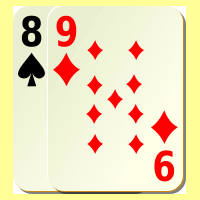By Michael Hartley
I wanted a simple card game to help teach basic addition facts. When I say 'basic', I mean really basic - at the level of 6+1=7. In the end, I came up with Fish Plus One.
Just as a reminder, here are the rules of "normal" Fish, a simple card game for two players.
- Players are dealt about 7 cards each. The rest of the cards are placed in a stack, face down on the table. The goal is to form pairs of matching cards. Every time you get a pair of cards which match (eg, two Kings, or two 4's, and so on - having two 'hearts' doesn't count as a match!), you place them face up on the table, in front of you.
- When it is your turn, you ask your opponent for a card. For example, if you had a 3 in your hand, you could ask "Can I have a 3?"
- If your opponent does have a 3, they give it to you. You now have a pair of 3's, which you lay face up on the table. Then, you get another turn.
- If your opponent doesn't have a 3, they say Fish!. You take a card from the stack. You might be lucky and get a card that matches one in your hand, or you might not. Either way, it is now your opponents turn.
- Play continues until someone runs out of cards.
Fish Plus One is a simple variation of Fish. Instead of making pairs of cards that match, they make pairs of cards that differ by one. So, for example...
- If I had a 3, I could ask my opponent Do you have a 4?
- And, when I get a 4, I can lay it down, saying 3 plus 1 is 4
It's probably best to remove all the picture cards before playing - teaching a young child that J means 11, and so on, might be too confusing. I use UNO cards with my son, after removing all the special cards.
If your kids play Fish Plus One, they'll quickly learn their addition facts from 1+1 to 9+1. Then, they'll be ready for Fish Plus Two! In Fish Plus Two, 3 would match with 5 instead of 4, because 3 plus 2 equals 5.
Then, you can play Fish Plus Three, or Fish Plus Four, and so on. But it night be better to move to Fish Plus Plus
In Fish Plus Plus,
- Instead of forming pairs, players try to get sets of three cards. A set can be any three cards where two of them add up to the other. So, for example, 3, 5 and 8 form a set of three.
- A player still must ask for cards that help them make matching sets. The exception is if they only have one card. Then they can ask for any card they like.
